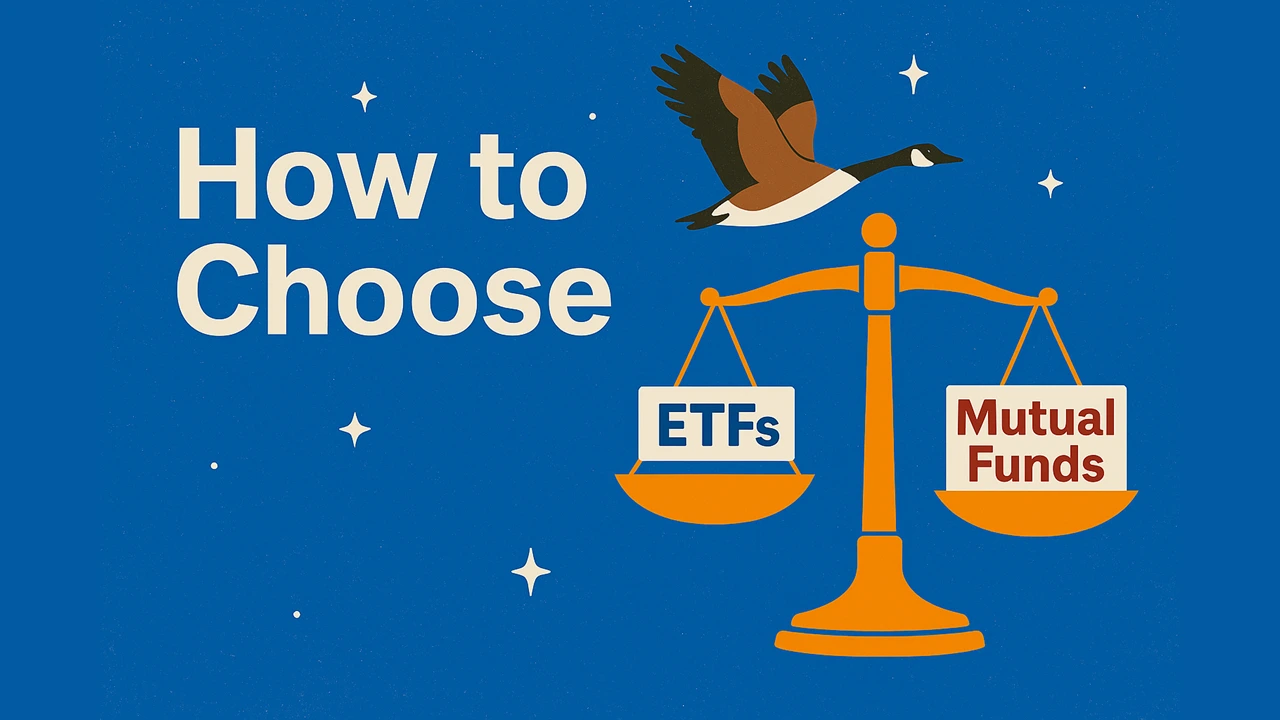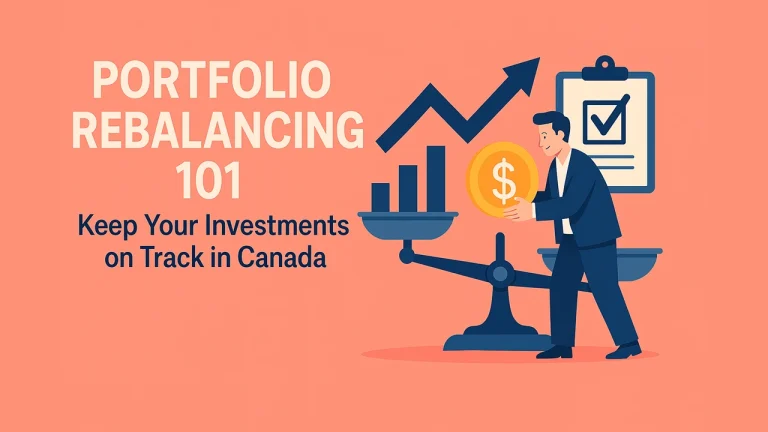How to Choose Between ETFs and Mutual Funds in Canada — And Avoid Big Mistakes

Canadians are bombarded with options — ETFs, mutual funds, robo-advisors. But when it comes to investing on your own, should you choose an ETF or a mutual fund?
This guide breaks down the pros, cons, and key differences — so you can make a smarter decision.
What are ETFs and Mutual Funds? (Basic Definitions)
If you’re new to investing in Canada, ETFs and mutual funds might sound like complicated products. But at their core, they’re simply ways to pool money with other investors to buy a diversified mix of assets — like stocks, bonds, or both.
Here’s how each one works:
What is a Mutual Fund?
A mutual fund is a professionally managed investment product that pools money from many investors to buy a portfolio of stocks, bonds, or other assets.
In Canada, mutual funds are commonly sold through:
- Banks (e.g. RBC, TD, Scotiabank)
- Financial advisors
- Online investing platforms
Key features:
- Professionally managed: A fund manager actively selects investments.
- Priced once per day: You buy or sell at the end-of-day price (NAV).
- Automatic investing options: Many Canadians use mutual funds for pre-authorized monthly contributions.
- Higher fees: Canadian mutual funds often have MERs (Management Expense Ratios) between 1.5% and 2.5%, especially if they’re actively managed.
What is an ETF?
An ETF (Exchange-Traded Fund) is an investment fund that also holds a basket of assets, but it’s traded on the stock market just like a regular stock.
ETFs are typically passively managed, which means they track a specific index — like the S&P/TSX Composite or the S&P 500 — instead of trying to beat the market.
Key features:
- Traded on an exchange: You can buy or sell ETFs anytime during market hours.
- Low-cost: Most ETFs have MERs under 0.25%, making them far cheaper than mutual funds.
- Held in brokerage accounts: You’ll need an online investing platform like Wealthsimple Trade, Questrade, or TD Direct Investing.
- Built for DIY investors: ETFs offer more control, but also require more involvement.
Key Similarities Between Them
While they’re structured differently, ETFs and mutual funds share a few important traits:
|
Feature |
Mutual Funds |
ETFs |
|---|---|---|
|
Diversification |
✅ |
✅ |
|
Professional management |
✅ (most) |
✅ (some) |
|
Hold multiple assets |
✅ |
✅ |
|
Eligible for RRSP/TFSA |
✅ |
✅ |
|
Can invest small amounts |
✅ |
✅ (with fractional shares) |
|
Canadian investor access |
✅ |
✅ |
Bottom line: Both products give you access to a diversified portfolio without needing to pick individual stocks — but how you buy them, what they cost, and how much control you have are very different, which we’ll explore next.
7 Key Differences Between ETFs and Mutual Funds (Comparison Table)
While mutual funds and ETFs can both help you grow your money, they work very differently under the hood — especially when it comes to cost, access, and how they fit into your financial habits.
Here are the seven key differences Canadian investors should know:
Fees and MERs (Management Expense Ratios)
- Mutual Funds: Most actively managed mutual funds in Canada have MERs between 1.5% and 2.5%. These fees are often embedded and may also include trailing commissions paid to advisors or banks — which eat into your returns over time.
- ETFs: Most ETFs, especially index ETFs, charge much lower MERs — often around 0.05% to 0.25%. There are no embedded advisor commissions, so you keep more of what you earn.
Bottom line: If cost matters (and it should), ETFs are typically the more efficient option.
How You Buy and Sell Them
- Mutual Funds: Bought or sold through your bank or advisor. Transactions happen once per day, at the closing price (NAV).
- ETFs: Traded on the stock exchange using a self-directed brokerage account (e.g. Questrade, Wealthsimple Trade). Prices fluctuate throughout the day like stocks.
Bottom line: ETFs offer real-time control, while mutual funds are more “hands-off.”
Investment Minimums
- Mutual Funds: Often require $500–$1,000 to start investing (though some bank funds allow as low as $25 with recurring deposits).
- ETFs: You can start with as little as the price of one share, and some brokerages offer fractional shares, letting you invest any amount.
Bottom line: ETFs may be easier to access for small, lump-sum investments; mutual funds are often better for small recurring contributions.
Tax Efficiency
- Mutual Funds: Actively managed mutual funds frequently buy and sell assets, which can trigger capital gains inside the fund, even if you don’t sell your units.
- ETFs: Generally more tax-efficient because of their unique “in-kind” structure, especially index ETFs. This helps reduce the amount of capital gains distributions to investors.
Bottom line: ETFs are generally more tax-friendly, especially in non-registered accounts.
Active vs. passive management
Mutual Funds: Most in Canada are actively managed, with fund managers trying to beat the market — often unsuccessfully and at a high cost.
ETFs: Most are passively managed, tracking indexes like the S&P/TSX, S&P 500, or FTSE Global All Cap. Some actively managed ETFs do exist, but they are less common.
Bottom line: Passive ETFs usually outperform active mutual funds after fees — and with less risk of underperformance.
Automation & Ease of Use
Mutual Funds: Very easy to set up automatic contributions through your bank or advisor. No brokerage required, no trading needed.
ETFs: Can be automated with robo-advisors or through pre-scheduled purchases in some brokerages, but generally require more effort for DIY investors.
Bottom line: Mutual funds win for simplicity and automation — unless you’re using a robo-advisor with ETFs.
Control and Customization
- Mutual Funds: You choose from a menu of funds, but you don’t control what’s inside them or when trades happen.
- ETFs: More flexibility to build your own portfolio, choose sectors, or adjust allocations. You’re in the driver’s seat.
Bottom line: ETFs give you more freedom — but also more responsibility.
Quick Comparison Table
|
Feature |
Mutual Funds |
ETFs |
|---|---|---|
|
Fees (MERs) |
1.5–2.5% (often hidden) |
0.05–0.25% (transparent) |
|
How to buy/sell |
Through bank/ advisor/ brokerage account, daily pricing |
Brokerage account, trades like a stock |
|
Minimum investment |
Often $500+ |
As little as one share (or fractional) |
|
Tax efficiency |
Lower (capital gains often triggered) |
Higher (tax-efficient structure) |
|
Management style |
Usually active |
Usually passive |
|
Automation |
Easy with banks |
Possible with robo-advisor or effort |
|
Investor control |
Limited |
High |
Cost Comparison: Real-World Examples in Canada
One of the biggest reasons Canadians switch from mutual funds to ETFs is cost. Even a 1–2% difference in fees can mean tens of thousands of dollars lost over time — just from fees, not investment performance.
Here’s how the math works in real life:
📉 Investing $10,000 in a Mutual Fund vs. ETF Over 20 Years
Let’s say you invest $10,000, leave it alone for 20 years, and assume a 6% average annual return before fees.
|
Scenario |
MER |
Net Return After Fees |
Ending Value After 20 Years |
|---|---|---|---|
|
Mutual Fund |
2.0% |
4.0% |
$21,911 |
|
ETD |
0.25% |
5.75% |
$30,403 |
💥 Difference: $8,492 lost to fees.
That’s 42% more growth just by switching from a high-fee mutual fund to a low-cost ETF. Literally no effort required.
Example Funds: TD Canadian Index Fund vs. iShares XIC ETF
Let’s compare two common Canadian index products:
🏦 TD Canadian Index Mutual Fund (e-Series)
- MER: 0.33%
- Minimum: $100 (or $25/month)
- Bought through TD EasyWeb or TD Direct
- Tracks: S&P/TSX Composite
📈 iShares Core S&P/TSX Capped Composite ETF (XIC)
- MER: 0.06%
- Trades on TSX like a stock
- Held in any online brokerage (Wealthsimple, Questrade)
- Also tracks: S&P/TSX Composite
Both funds hold nearly the same investments, but the ETF charges less than one-fifth the fee.
Over 30 years, on a $100,000 investment, the difference in fees could exceed $8,000–$10,000, depending on growth rates.
Hidden Costs: Advisor Commissions and Trailer Fees
Many Canadian mutual funds come with embedded commissions called trailing fees, which:
- Pay your advisor or bank rep every year (from your returns)
- Can incentivize advisors to recommend funds that pay them, not serve you
- Still apply even if you never speak to a human advisor
ETFs do not have trailer fees — you only pay the low, transparent MER. Some brokers (like Questrade or Wealthsimple Trade) even offer commission-free ETF purchases, making them even more cost-effective.
Pro Tip
ETFs almost always win on cost. Especially for self-directed Canadian investors.
When Mutual Funds Might Make More Sense
ETFs usually offer lower fees and more flexibility, but they aren’t always the best option — especially for beginners or those who want a fully hands-off approach.
Here are a few situations where mutual funds might actually be the smarter choice for certain Canadian investors.
You Want Simplicity Without Opening a Brokerage
Many Canadians prefer to invest directly through their bank. Mutual funds are:
- Easy to buy through online banking platforms (like RBC Direct Investing or TD EasyWeb)
- Integrated with your chequing and savings accounts
- Often available with just a few clicks and no separate investing platform
If you’re not ready to open a brokerage or manage your own trades, mutual funds offer a much easier on-ramp to investing.
You’re Making Small, Regular Contributions
Most mutual funds allow:
- Pre-authorized contributions starting as low as $25/month
- Automatic investment plans that work like “set it and forget it”
This makes mutual funds ideal for:
- New investors building a habit
- People paid biweekly or monthly who want to invest a fixed amount without logging in
While ETFs can be automated with some brokers or robo-advisors, mutual funds make it very simple to automate without needing extra tools.
When ETFs Are the Smarter Choice
While mutual funds offer convenience, ETFs give you more control, lower fees, and greater long-term growth potential — especially if you’re willing to use an online brokerage or robo-advisor. Here’s when ETFs are likely the better move:
You Want to Minimize Fees Long-Term
ETFs have significantly lower MERs than traditional mutual funds. For example:
- A broad Canadian equity mutual fund may cost 2.0%+
- A similar ETF (like XIC or VCN) costs ~0.06%
That difference might sound small, but it can cost you tens of thousands of dollars over your investing lifetime.
If you believe in buy-and-hold investing, then lowering fees is one of the easiest ways to increase your returns — and ETFs make that possible.
You’re Comfortable Using an Online Brokerage
To buy ETFs, you’ll need a self-directed investment account with a brokerage like:
- Wealthsimple Trade (zero commission on ETF trades)
- Questrade (free ETF purchases, low cost to sell)
- TD Direct Investing, RBC Direct Investing, etc.
Once your account is set up, buying an ETF is as easy as placing a stock order. Many platforms even allow:
- Recurring contributions to your account
- Fractional ETF purchases (Wealthsimple Trade)
If you’re comfortable logging in and executing a trade every now and then, ETFs give you much more flexibility and control.
You Want More Flexibility and Control
ETFs offer access to:
- Canadian, U.S., and global markets
- Bonds, REITs, commodities, and more
- Specialized sectors, like tech, ESG, or dividend-paying stocks
That means you can:
- Build your own diversified portfolio
- Adjust your risk level over time
- Add or remove holdings as your strategy evolves
This kind of customization is difficult (or expensive) with mutual funds, which are more rigid and “all-in-one” by design.
The Smartest Option Might Be a Robo-Advisor
If you like the idea of low-cost ETFs but don’t want to manage trades, rebalance your portfolio, or think about asset allocation, a robo-advisor might be the smartest middle-ground.
Robo-advisors in Canada use automated technology to build and manage ETF portfolios for you — no stock picking or rebalancing required.
What is a Robo-Advisor?
A robo-advisor is an online investment platform that:
- Asks you a few questions about your goals, risk tolerance, and time horizon
- Automatically builds a diversified ETF portfolio for you (stocks + bonds)
- Handles rebalancing, dividend reinvestment, and portfolio monitoring
You don’t have to choose specific ETFs or worry about buying/selling — it’s completely hands-off.
Pros: Simplicity With Low Fees
Robo-advisors combine the automation of mutual funds with the low fees of ETFs. Most charge:
- A management fee of 0.25% to 0.50%
- Plus the ETF MERs (usually ~0.15% to 0.20%)
That brings the all-in cost to around 0.40% to 0.70% — much lower than traditional mutual funds, and you don’t have to manage anything yourself.
Other benefits include:
- Free automatic rebalancing
- Tax-efficient account features (e.g. tax-loss harvesting at Wealthsimple)
- Access to RRSPs, TFSAs, FHSAs, and even joint or corporate accounts
Best Robo-Advisors in Canada (2025)
|
Robo-Advisor |
Management Fee |
Minimum Investment |
Highlights |
|---|---|---|---|
|
Wealthsimple Invest |
0.40–0.50% |
$0 |
Free rebalancing, no trading fees, strong UI |
|
Questwealth |
0.25% |
$1,000 |
Ultra-low fees, customizable portfolios |
|
Justwealth |
0.50% |
$5,000 |
Best for RESPs (custom target-date portfolios) |
|
CI Direct Investing |
0.40–0.50% |
$1,000 |
Strong planning tools and legacy support |
Pro Tip
Most robo-advisors offer free transfers from other institutions, including RRSPs and TFSAs — even from your bank.
Conclusion
Choosing between mutual funds, ETFs, and robo-advisors really comes down to what matters most to you: simplicity, control, or long-term savings.
Here’s the quick breakdown:
- 🛋️ Go with mutual funds if you want pure convenience — easy to set up at your bank, with automatic contributions and zero hands-on effort.
- 💸 Go with ETFs if you want the lowest fees and more control over your investments — great for DIY investors using a brokerage.
- 🤖 Go with a robo-advisor if you want low-cost ETF investing without managing the details yourself — it’s automation with serious savings.
At the end of the day, the best option is the one you’ll actually use and feel comfortable with. But if you’re looking to build wealth over time, lower fees = more money in your pocket, and that’s where ETFs (or robo-advisors) shine.

